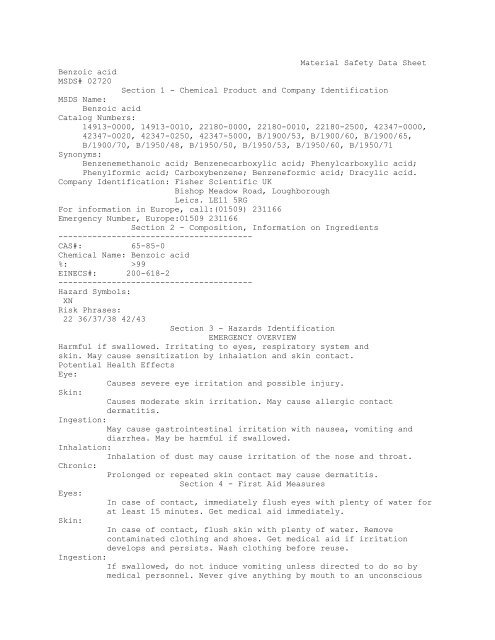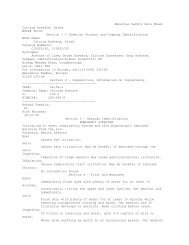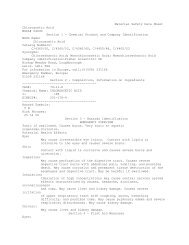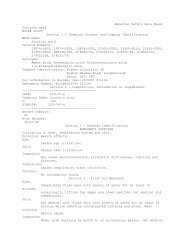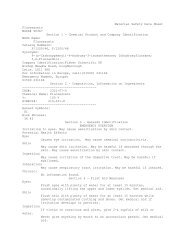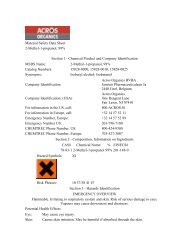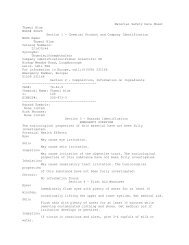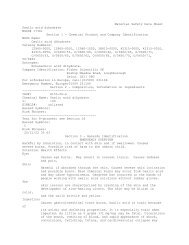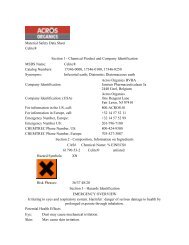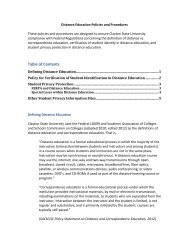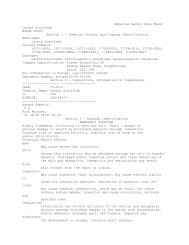Material Safety Data Sheet Benzoic acid MSDS# 02720 Section 1 ...
Material Safety Data Sheet Benzoic acid MSDS# 02720 Section 1 ...
Material Safety Data Sheet Benzoic acid MSDS# 02720 Section 1 ...
- No tags were found...
You also want an ePaper? Increase the reach of your titles
YUMPU automatically turns print PDFs into web optimized ePapers that Google loves.
<strong>Material</strong> <strong>Safety</strong> <strong>Data</strong> <strong>Sheet</strong><strong>Benzoic</strong> <strong>acid</strong><strong>MSDS#</strong> <strong>02720</strong><strong>Section</strong> 1 - Chemical Product and Company IdentificationMSDS Name:<strong>Benzoic</strong> <strong>acid</strong>Catalog Numbers:14913-0000, 14913-0010, 22180-0000, 22180-0010, 22180-2500, 42347-0000,42347-0020, 42347-0250, 42347-5000, B/1900/53, B/1900/60, B/1900/65,B/1900/70, B/1950/48, B/1950/50, B/1950/53, B/1950/60, B/1950/71Synonyms:Benzenemethanoic <strong>acid</strong>; Benzenecarboxylic <strong>acid</strong>; Phenylcarboxylic <strong>acid</strong>;Phenylformic <strong>acid</strong>; Carboxybenzene; Benzeneformic <strong>acid</strong>; Dracylic <strong>acid</strong>.Company Identification: Fisher Scientific UKBishop Meadow Road, LoughboroughLeics. LE11 5RGFor information in Europe, call:(01509) 231166Emergency Number, Europe:01509 231166<strong>Section</strong> 2 - Composition, Information on Ingredients----------------------------------------CAS#: 65-85-0Chemical Name: <strong>Benzoic</strong> <strong>acid</strong>%: >99EINECS#: 200-618-2----------------------------------------Hazard Symbols:XNRisk Phrases:22 36/37/38 42/43<strong>Section</strong> 3 - Hazards IdentificationEMERGENCY OVERVIEWHarmful if swallowed. Irritating to eyes, respiratory system andskin. May cause sensitization by inhalation and skin contact.Potential Health EffectsEye:Causes severe eye irritation and possible injury.Skin:Causes moderate skin irritation. May cause allergic contactdermatitis.Ingestion:May cause gastrointestinal irritation with nausea, vomiting anddiarrhea. May be harmful if swallowed.Inhalation:Inhalation of dust may cause irritation of the nose and throat.Chronic:Prolonged or repeated skin contact may cause dermatitis.<strong>Section</strong> 4 - First Aid MeasuresEyes:In case of contact, immediately flush eyes with plenty of water forat least 15 minutes. Get medical aid immediately.Skin:In case of contact, flush skin with plenty of water. Removecontaminated clothing and shoes. Get medical aid if irritationdevelops and persists. Wash clothing before reuse.Ingestion:If swallowed, do not induce vomiting unless directed to do so bymedical personnel. Never give anything by mouth to an unconscious
person. Get medical aid.Inhalation:If inhaled, remove to fresh air. If not breathing, give artificialrespiration. If breathing is difficult, give oxygen. Get medicalaid.Notes to Physician:Persons with asthma, chronic respiratory disease, skin disorders,eye problems or allergies may be at increased risk from exposure tothis substance.<strong>Section</strong> 5 - Fire Fighting MeasuresGeneral Information:As in any fire, wear a self-contained breathing apparatus inpressure-demand, MSHA/NIOSH (approved or equivalent), and fullprotective gear. Water runoff can cause environmental damage. Dikeand collect water used to fight fire. During a fire, irritating andhighly toxic gases may be generated by thermal decomposition orcombustion. This material in sufficient quantity and reducedparticlesize is capable of creating a dust explosion. Reacts with mostmetalsin the presence of moisture, liberating extremely flammablehydrogengas.Extinguishing Media:Use water spray, dry chemical, carbon dioxide, or chemical foam.<strong>Section</strong> 6 - Accidental Release MeasuresGeneral Information:Use proper personal protective equipment as indicated in <strong>Section</strong> 8.Spills/Leaks:Avoid runoff into storm sewers and ditches which lead to waterways.Clean up spills immediately, observing precautions in theProtectiveEquipment section. Avoid generating dusty conditions. Provideventilation. Cover with soda ash or sodium bicarbonate and place inaclosed container for disposal.<strong>Section</strong> 7 - Handling and StorageHandling:Wash thoroughly after handling. Use with adequate ventilation.Minimize dust generation and accumulation. Avoid contact with eyes,skin, and clothing. Wash clothing before reuse. Avoid breathingdust.Storage:Store in a cool, dry, well-ventilated area away from incompatiblesubstances.<strong>Section</strong> 8 - Exposure Controls, Personal ProtectionEngineering Controls:Facilities storing or utilizing this material should be equippedwith an eyewash facility and a safety shower. Use adequateventilation to keep airborne concentrations low.Exposure LimitsCAS# 65-85-0:Personal Protective EquipmentEyes:Wear appropriate protective eyeglasses or chemicalsafety goggles as described by OSHA's eye and faceprotection regulations in 29 CFR 1910.133 or European
Skin:Clothing:Respirators:Standard EN166.Wear appropriate protective gloves to prevent skinexposure.Wear appropriate protective clothing to prevent skinexposure.A respiratory protection program that meets OSHA's 29CFR 1910.134 and ANSI Z88.2 requirements or EuropeanStandard EN 149 must be followed whenever workplaceconditions warrant respirator use.<strong>Section</strong> 9 - Physical and Chemical PropertiesPhysical State:Crystalline powderColor:whiteOdor:pleasant odorpH:2.8 (satd soln)Vapor Pressure:0.0012 mm Hg @ 25 deg CViscosity:Not availableBoiling Point:249.2 deg C @ 760 mmHg ( 480.56F)Freezing/Melting Point: 122.4 deg C ( 252.32F)Autoignition Temperature: 570 deg C ( 1,058.00 deg F)Flash Point: 121 deg C ( 249.80 deg F)Explosion Limits: Lower:Not availableExplosion Limits: Upper:Not availableDecomposition Temperature: Not availableSolubility in water: 3.4 g/l @ 25CSpecific Gravity/Density: Not available.Molecular Formula:C7H6O2Molecular Weight: 122.12<strong>Section</strong> 10 - Stability and ReactivityChemical Stability:Stable under normal temperatures and pressures. Volatile in steam.Conditions to Avoid:Dust generation, excess heat.Incompatibilities with Other <strong>Material</strong>sStrong oxidizing agents, strong bases, amines, ammonia,isocyanates,Solutions attack some metals..Hazardous Decomposition ProductsCarbon monoxide, carbon dioxide, phenol, benzene.Hazardous PolymerizationHas not been reported.<strong>Section</strong> 11 - Toxicological InformationRTECS#:CAS# 65-85-0: DG0875000LD50/LC50:RTECS: CAS# 65-85-0: Draize test, rabbit, eye: 100 mgSevere; Draize test, rabbit, skin: 500 mg/24H Mild;Inhalation, rat: LC50 = >26 mg/m3/1H; Oral, mouse: LD50 = 1940mg/kg; Oral, rat: LD50 = 1700 mg/kg; Skin, rabbit: LD50 = >10gm/kg;.Other: Human TDLo skin of 6 mg/kg produced dyspnea (difficult orlabored breathing) and allergic dermatitis.Carcinogenicity:<strong>Benzoic</strong> <strong>acid</strong> -Not listed as a carcinogen by ACGIH, IARC, NTP, or CA Prop 65.
Other:See actual entry in RTECS for complete information.<strong>Section</strong> 12 - Ecological InformationEcotoxicity:Fish: Mosquito Fish: LC50 = 180 mg/L; 96 Hr; UnspecifiedBacteria:Phytobacterium phosphoreum: EC50 = 16.9 mg/L; 96 Hr; Microtox test @15C<strong>Section</strong> 13 - Disposal ConsiderationsDispose of in a manner consistent with federal, state, and local regulations.<strong>Section</strong> 14 - Transport InformationIATAShipping Name:Not regulated.Hazard Class:UN Number:Packing Group:IMOShipping Name:Not regulated.Hazard Class:UN Number:Packing Group:RID/ADRShipping Name:Not regulated.Hazard Class:UN Number:Packing Group:USA RQ: CAS# 65-85-0: 5000 lb final RQ; 2270 kg final RQ<strong>Section</strong> 15 - Regulatory InformationEuropean/International RegulationsEuropean Labeling in Accordance with EC DirectivesHazard Symbols: XNRisk Phrases:R 22 Harmful if swallowed.R 36/37/38 Irritating to eyes, respiratory systemand skin.R 42/43 May cause sensitization by inhalation andskin contact.<strong>Safety</strong> Phrases:S 22 Do not breathe dust.S 24 Avoid contact with skin.S 26 In case of contact with eyes, rinse immediatelywith plenty of water and seek medical advice.S 37/39 Wear suitable gloves and eye/faceprotection.S 45 In case of accident or if you feel unwell, seekmedical advice immediately (show the label wherepossible).WGK (Water Danger/Protection)CAS# 65-85-0: 1CanadaCAS# 65-85-0 is listed on Canada's DSL ListUS FederalTSCACAS# 65-85-0 is listed on the TSCA Inventory.<strong>Section</strong> 16 - Other InformationMSDS Creation Date:2/15/1999Revision #9 Date
6/06/2006Revisions were made in <strong>Section</strong>s:9The information above is believed to be accurate and represents thebest information currently available to us. However, we make nowarranty of merchantibility or any other warranty, express orimplied, with respect to such information, and we assume no liabilityresulting from its use. Users should make their own investigations todetermine the suitability of the information for their particularpurposes. In no event shall the company be liable for any claims,losses, or damages of any third party or for lost profits or anyspecial, indirect, incidental, consequential, or exemplary damageshowsoever arising, even if the company has been advised of thepossibility of such damages.--------------------------------------------------------------------------------


